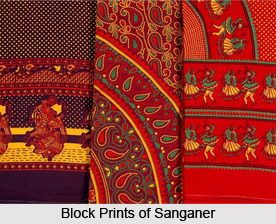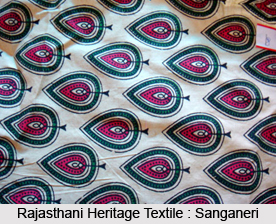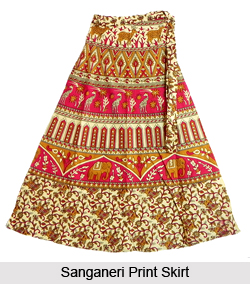 Rajasthan is famous in India for its dyeing, printing and embroidery cloth since centuries. Floral, geometrical or animal motifs are major designs of printing. Sanganer near Jaipur is the center for block and screen-printed cotton cloth. The fascinating range of block-printed fabric in bold colors may be further embellished by embroidery. The Sanganeri block prints usually consist of floral motif. Basic colors are scarlet, black and brown. But now, with increasing technology and use of synthetic dyes, unusual combinations of scarlet and pink, purple and orange, turquoise and green are gaining market demand. The Sanganer prints are always on a white background famous for its artistry and intricacy of design.
Rajasthan is famous in India for its dyeing, printing and embroidery cloth since centuries. Floral, geometrical or animal motifs are major designs of printing. Sanganer near Jaipur is the center for block and screen-printed cotton cloth. The fascinating range of block-printed fabric in bold colors may be further embellished by embroidery. The Sanganeri block prints usually consist of floral motif. Basic colors are scarlet, black and brown. But now, with increasing technology and use of synthetic dyes, unusual combinations of scarlet and pink, purple and orange, turquoise and green are gaining market demand. The Sanganer prints are always on a white background famous for its artistry and intricacy of design.
Various floral designs, geometrical and God figures are included in its prints. Folk designs are also found as they retain the basic Sanganeri printing style. Now-a-days beside traditional prints, modern designs are also found on block printed cloth. Instead of hand block printing these days screen printing is getting popular. The traditional ghagras of Rajasthan carry these block prints in a very artistic manner. These ghagras with added style has a place in the fashion world.

Fine Art of Sanganeri Prints
Block Printing is done with the help of wooden blocks, known as Chhapas or buntis found in different shapes and sizes. Blocks are made of seasoned teak wood with design on the underside of the block. These blocks are dipped into dye to print the pattern on the cloth. These wooden blocks have different floral motif carved on them. These blocks are the main tools of the printer. The blocks are designed in such a way that it allows release of excess printing dye. The new blocks are soaked in oil for 10-15 days to soften the grains in the timber. The printing table is long enough so that good number of fabric could be printed altogether. The fabric to be printed is pinned over the table and printed block by block.
Cloth is bleached and then folded into two or four layers depending on the thickness of the cloth, before printing. The design or the layout of the pattern is made using wooden blocks dipped in geru, a burnt sienna color mixed with water.
In the traditional Sanganeri prints, the ground is in white or pastel shades with floral cones and sprays scattered with in symmetrical borders. The chhipas of Bagru produce a variety of fabrics printed in motifs of the gulab or rose, neem leaf, gobi or cauliflower, mirchi or Chili, mukut (crown), dhaniya ki bel (coriander sprig or creeper).
 Kota was traditionally known for its blue - black saris. Jodhpur prints were often masked by dense bands running the length of the fabric in scarlet or brick - red, orange and lemon on moss - green or indigo blue. The jarribhat sari which is the wedding dress of the local people has an interesting design worked from squares. Chittorgarh, an important erstwhile principality of the Ranas of Mewar, had a large number of printers who print fabric for ghagras with stylished Mirch buta distributed over an Indian red background. Block printing has become popular because of the simple process which can create such amazing prints and that too in bold and vibrant colors.
Kota was traditionally known for its blue - black saris. Jodhpur prints were often masked by dense bands running the length of the fabric in scarlet or brick - red, orange and lemon on moss - green or indigo blue. The jarribhat sari which is the wedding dress of the local people has an interesting design worked from squares. Chittorgarh, an important erstwhile principality of the Ranas of Mewar, had a large number of printers who print fabric for ghagras with stylished Mirch buta distributed over an Indian red background. Block printing has become popular because of the simple process which can create such amazing prints and that too in bold and vibrant colors.
The printing table is covered with sand sprinkled with water which is then covered by a wet cloth. A special block with raised surface and deep grooves is dipped in liquid wax and pressed over the cloth and when it comes into contact with the cool surface, it solidifies the wax. The whole material is next dyed in dark red colour and dipped in hot water to melt the wax. The piece presents interesting tonal effects.



















